
King Abdullah II House of Culture & Art by Zaha Hadid Architects
Zaha Hadid Architects have unveiled their design for a new performing arts centre in Amman, the capital of Jordan.
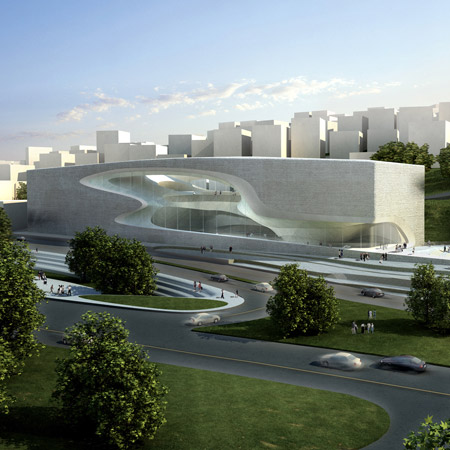
The design of the King Abdullah II House of Culture & Art derives from the carved stone buildings and eroded rock formations at Petra in Jordan.
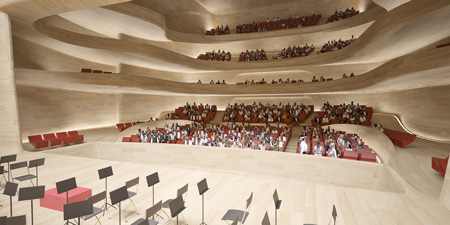
See all our stories about Zaha Hadid in our special category.
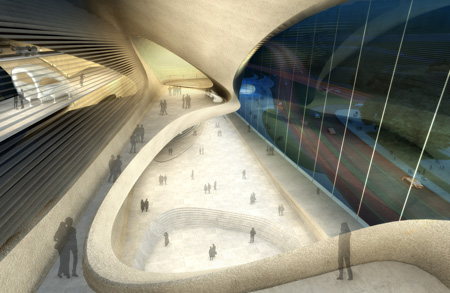
Here's a press release from Zaha Hadid Architects followed by a design statement:
22 February, 2010 - At a ceremony in the Jordanian capital, His Excellency Omar Maani, the mayor of Amman, announced the new King Abdullah II House of Culture & Art by Zaha Hadid Architects - a performing arts and cultural centre that includes a 1600-seat concert theatre, 400-seat theatre, educational centre, rehearsal rooms, and galleries.
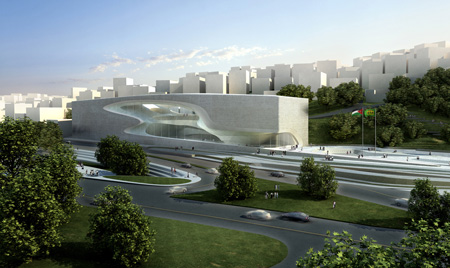
At the directives of His Majesty King Abdullah II Ibn Al Hussein, the Greater Amman Municipality is creating a new venue for performing arts and culture in a prime location in the centre of Amman. Conceived as a place to rehearse, discuss, teach, study and perform, the King Abdullah II House of Culture & Art will be the premiere venue for theatre, music and dance performance and education in Jordan – a vital element in the cultural life of the city and country, bringing together all members of the community in the shared experience of art and music.
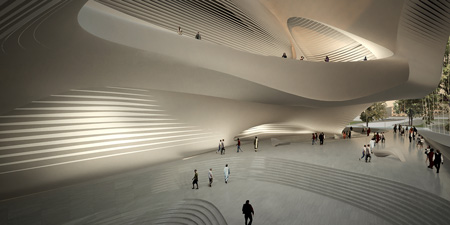
The architectural expression for the new performing arts centre has been inspired by the magnificent ancient city of Petra explains Zaha Hadid. “Petra is an astonishing example of the wonderful interplay between architecture and nature, as well as the intricate complexity and elegance of natural forms - the rose-colored mountain walls have been eroded, carved and polished to reveal the astonishing strata of sedimentation. We have applied these principles to articulate the public spaces within the centre, with eroded interior surfaces that extend into the public plaza in front of the building.”
Zaha Hadid Architects was awarded the project in June 2008 after an international competition that included Snøhetta (Norway), Atelier Christian de Portzamparc (France), Delugan Meissl (Austria), Henning Larsens Tegnestue (Denmark) and Kerry Hill Architects (Singapore). Mayor Maani announced today that the Greater Amman Municipality have now signed the contract with Zaha Hadid Architects to build the King Abdullah II House of Culture & Art.
Zaha Hadid Architects
King Abdullah II House of Culture & Art
Project Explanation
Architectural Concept
The architectural expression for the new performing arts centre has been inspired by the uniquely beautiful monument of Petra. As an artificial oasis and sanctuary the ancient city of Petra is an appropriate source of analogy for a performing arts centre that aspires to be an oasis and sanctuary for contemporary culture.
Petra is also a fantastic example of the wonderful interplay between architecture and nature. Contemporary architecture is striving to emulate nature and imbue architecture with the intricate complexity and elegance of natural forms. In Petra we admire the way the rose-colored mountain walls have been fissured, eroded, carved and polished to reveal the strata of sedimentation along the fluid lines of the fluvial erosions.
We are applying the principle of fluid erosion and carving to the mass of the building for the performing arts centre. This principle of erosion is the sole means of articulating the public spaces in the building. Thus there is a very strong, legible relation between the exterior and interior public spaces.
The interior public foyer space is a continuous, multi-level space that cuts through the building and connects the north and south side of the valley. The fact that the erosion is cutting through the building implies that the beautiful interior surfaces will be light-flooded and thus very visible from without.
The eroded interior surface extends deep into the public plaza as a welcoming gesture drawing the public into the building. There can be no doubt that this inviting design will wash away the threshold anxiety that sometimes is felt in front of monumental cultural buildings.
While the erosion creates the public foyer spaces the remaining mass represents the performance spaces. The shape of the eroded space reveals the two main performance spaces as the figurative parts of the eroded mass. The big Concert Theater is exposed at the end of the public void. The Small Theater is exposed overhead at the front of the building where the public foyer space fuses with the public plaza. These two recognizably shaped volumes that contain the primary event spaces are then encapsulated by the support functions to create the exterior cubic volume.
However, this exterior volume is not a rigid box. The volume is given tension be letting it gently swell - like the entasis of a column - in response to the public void in the centre of the building. Another nuance is to be noticed with respect to the treatment of the ground-surface – both on the plaza and within the public foyer.
The plaza ground outside receives the underpass coming from the GAM strip and thus creates an amphi-theatre-like valley. The surface of the plaza rises gently as it approaches the building. The foyer ground is thus slightly raised and dips again slightly in response to the Small Theatre. The ground is eroded again in front of the big Concert Theater to reveal and give access to this performance space creating another situation that might become a kind of amphi-theatre within the overall space.
Such quasi-topographic manipulations of the ground surface are very communicative. They help to structure the large public surface and facilitate orientation and overview, in particular if the space is filled with people. Thus this play with the ground plane goes hand in hand with the overall ambitions of the multi-level public void that allows the audience to participate in the unified public space on many levels. In particular the second, elevated foyer level that connects across to the south-side of the valley might become Aman’s favorite spot to relax and enjoy the city.